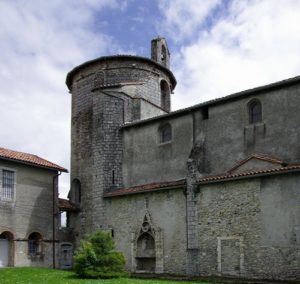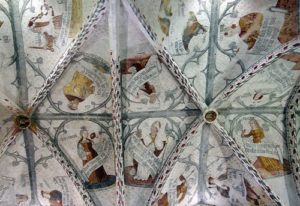Prefectural Museum of Ariège is in part of the Bishop’s Palace in the upper walled town of St Lizier. Entry to the museum also includes Notre-Dame de Séde, the cathedral until 1801. Built along the line of the ramparts the Bishop’s Palace is a massive four storey stone building with round towers at the corner with a red pantiles roof.
The sumptuous palace was built in 1675 after the Bishopric was combined in 1655 and St Giron’s in the lower town, lost its status as a Cathedral. After the bishopric was abolished in 1801, the building served as town hall, prison, poorhouse and lunatic asylum. Part of it houses a restaurant, the rest has been restored as a museum covering the history of the city since Roman times with a series of permanent and temporary exhibitions.
Entry is through an archway off rue Notre-Dame. The former stables is the ticket office and shop.
The museum is beautifully laid out on four floors but there is little inside. The first floor covers Roman history and includes artefacts from the local area. There are amphorae, funeral stones and the St Giron’s treasure trove of coins, a huge lump of verdigris coins stuck together. There are a few cleaned up specimens of gold and silver coins.
The second floor covers the Gallo-Roman period and there are two 5th sarcophagi and examples of carved stone capitals.
The third floor covers the arrival of Christianity and has display board about St Jacques de Compostela. There is a display of pigments used in the murals and some history of the Bishop’s Palace.
On the top floor there is some information about life in a Pyrenean village at the start of the 20thC, with a display of costumes, wooden furniture including a wool winder, bed frame, crib, playpen and a wooden dresser. There is a shepherd’s cloak made of thick rough wool and branding irons for sheep.
Notre-Dame de Sède is reached through the museum. It is a very tall building with buttressed nave and a large round tower with a small bell cote at the east end. On the outside of the south wall is a Gothic apse with pinnacles.
The building is 14thC on the site of a 6thC basilica built over the tomb of St Valier. It is regarded as one of the most beautiful buildings in the Midi-Pyrenees.
Entry is through the a big doorway with pointed arches and pillars with very eroded capitals. Inside it is a very light and airy building. The vaulted ceiling with carved and painted bosses is covered with 15/16thC frescoes of figures in red and yellow robes with scrolls with a Latin inscription. These are set in a network of grey branches. According to the guide books, the frescoes represent the twelve patriarchs founding the twelve tribes of Israel and the twelve sibyls heralding the coming of Christ. There are also scenes from the life of Saint Jacques de Compostela. There is no written information in the church although there is an interactive computer screen with a rather clunky program. This lets you move around the ceiling, select an image, enlarge it and get some information about it. This is all in French and there is no choice of language.
The nave windows are plain glass and set high on the walls and there are more frescoes around them.
The wall pillars are painted to ensemble grey marble flecked with red and lead to the ribs of the vaulted ceiling. These have a dark grey flower motif with red diamonds on a white background along the sides.
The chancel arch has carved panels on the underside with a red background and yellow flowers. On the front of the arch are roundels with blue or red designs on beige. At the centre is a M monogram on deep royal blue. The chancel ceiling is blue with angel heads in clouds. The round window has modern stained glass. There is wooden rail across the chancel. On the right is a wooden pulpit with sounding board above. Round the walls are tall carved wood panels with roundels along the top with carved figures. Round the back of the apse are two rows of choir stalls with carved arms and misericords. At the centre is the Bishop’s throne with a canopy above and a reading desk in front. The free standing gilt altar has a carving of a lamb on the front above a shield with cherub heads on either side. On top is a small wooden host box.
At the west end, pillars support a balcony with a tiny Romanesque window above.
There is a dark wood altar set in an arch on the north wall of the nave. The host box has a pelican plucking her breast to feed her young. Wooden fluted pillars with gilt capitals support a portico with a cross at the top. In the centre is a painting of two angels with cherub heads around two sacre coeurs with blood dripping from them. One is pierced by a spear; the other has a cross on top. On either side are wooden pillars painted to resemble marble. They are set in an rah of blue and grey panels with a pattern leading to the top with a sacre coeur with a crown of thorns set in a sunburst. The arch round the altar and pillars is painted in a rather garish design with deep blue pillars and yellow flowers.
There are two small chapels on the south wall which contain old wooden altars which have lost their paintings and statues.
We were disappointed by the museum which we felt was low on content. The only reason to visit is for entry to Notre-Dame de Sède. We had been looking forward to the visit, but somehow, this didn’t deliver for us either.









